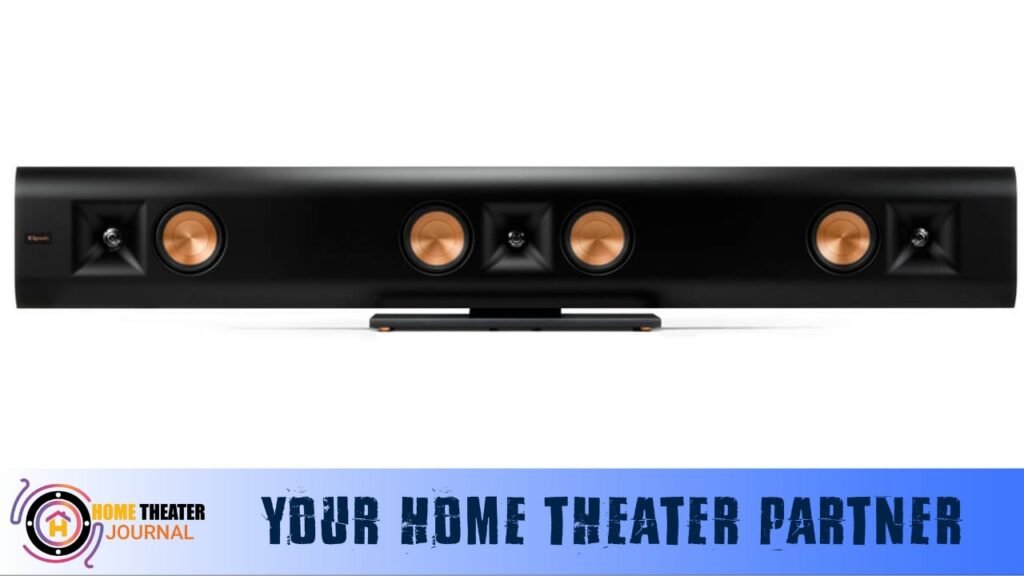Does a Soundbar Replace a Receiver? Helpful Guide
In the ever-evolving world of home theater setups, the question of whether a soundbar can effectively replace a receiver is a common consideration.
As technology advances, so do the features embedded in soundbars, making them an attractive option for those looking to streamline their audio systems.
In this post, we’ll delve into the specifics of active and passive soundbars, discussing how they may or may not replace the traditional receiver.
Table of Contents
Active Soundbars:

Active soundbars have emerged as a self-contained audio solution, incorporating both surround sound processing and amplifiers within a single unit.
This integration simplifies the setup process, as users only need to connect the soundbar to the TV through the component outlet. The appeal lies in the reduction of bulk and the elimination of excessive wiring, making active soundbars an attractive option for those with space constraints or a preference for a minimalist home theater design.
How Active Soundbars Replace Receivers:
Replacing a traditional receiver with a soundbar involves understanding the features and capabilities of both devices. Below is a detailed explanation of how exactly a soundbar can replace a receiver, focusing on the functionalities of active soundbars, which come equipped with built-in surround sound processing and amplifiers.
1. Active Soundbars as Self-Contained Units:
- Built-in Surround Sound Processing: Active soundbars are designed with integrated surround sound processing capabilities. This means they can decode and process audio signals to create a simulated surround sound experience without the need for an external receiver. This is particularly advantageous for users seeking a simple and compact audio solution.
- Amplification within the Soundbar: Active soundbars also feature built-in amplifiers. These amplifiers power the speakers within the soundbar, eliminating the requirement for a separate receiver to handle the amplification process. This self-contained design reduces the number of components in the audio setup.
2. Simplified Setup Process:
- Connection to the TV: Active soundbars typically connect directly to the television through a designated component outlet. This streamlined setup process eliminates the complexities associated with wiring and configuring a separate receiver. Users can enjoy enhanced audio without the need for extensive technical knowledge or additional equipment.
- Reduced Bulk and Wiring: One of the key advantages of using an active soundbar as a receiver replacement is the reduction in bulk and the elimination of excessive wiring. Traditional surround sound systems often involve multiple speakers, a receiver, and intricate wiring. With an active soundbar, the entire audio solution is consolidated into a single unit.
3. Compatibility Considerations:
- Limitations with External Speakers: While active soundbars excel at providing an all-in-one audio solution, they may have limitations when it comes to compatibility with external speakers. These soundbars are optimized to work seamlessly with their built-in speakers, and connecting additional speakers may require careful consideration of matching ports and compatibility.
- Alternative Options for Surround Sound: In cases where users desire a more expansive surround sound setup with external speakers, alternative options such as digital surround sound speakers or a traditional receiver-based system may be more suitable. Researching the soundbar’s specifications is crucial to ensure compatibility with external components.
4. Pros and Cons of Using a Soundbar as a Receiver:
Pros:
Fewer Wires and Streamlined Design: Active soundbars contribute to a cleaner aesthetic with fewer visible wires.
Cost-Effective: For users needing both a receiver and a passive soundbar, opting for an active soundbar can be more cost-effective.
Achievable Digital Surround Sound: Active soundbars can deliver a convincing digital surround sound effect using a single speaker.
Cons:
Potential Higher Cost: Active soundbars may carry a higher upfront cost compared to entry-level receivers.
Sound Quality Discrepancies: The audio quality from a single soundbar may not match the immersive experience of a full surround sound speaker setup.
Amplifier Quality: Receivers often house superior amplifiers, impacting overall audio performance.
Considerations for Using a Receiver with a Soundbar:

Using a soundbar alone can be an excellent solution for many home audio setups, providing a streamlined and space-efficient alternative to traditional receiver-based systems. However, there are certain scenarios where incorporating a receiver into your setup remains essential. Understanding when you might need a receiver with a soundbar involves considering various factors, including the type of soundbar, audio preferences, and the desire for a more expansive audio experience.
Passive Soundbars:
- Multiple Channels: Passive soundbars often come with multiple channels, such as the center, left, and right channels. Each channel may have one or more speakers, and these channels require connections to a receiver. If you opt for a passive soundbar, a receiver becomes a necessary component to process and distribute the audio signals to the respective channels.
- External Amplification: Passive soundbars lack built-in amplifiers, relying on an external amplifier or receiver to power the speakers. In this case, a receiver is not just a convenience but a requirement for the proper functioning of the sound system.
Enhanced Surround Sound Systems:
- Expanding the Audio Setup: If you have a vision of expanding your audio setup beyond a single soundbar, incorporating additional speakers for a more immersive surround sound experience, a receiver becomes crucial. A receiver is designed to manage and distribute audio signals to multiple speakers, optimizing the synchronization of sound elements in a multi-channel setup.
- Speaker Compatibility: Receivers provide the necessary connections and compatibility for a diverse range of speakers. If you plan to integrate rear speakers, a subwoofer, or even overhead speakers for a Dolby Atmos setup, a receiver is the central hub that can accommodate these components.
Customization and Fine-Tuning:
- Audio Processing Capabilities: Receivers typically offer advanced audio processing capabilities that can enhance the overall sound quality. They may include features like room calibration, equalization, and various sound modes. If you seek a high level of customization and fine-tuning to match your preferences and room acoustics, a receiver provides the necessary controls.
- Diverse Audio Sources: Receivers often come equipped with multiple input ports, allowing you to connect various audio sources such as Blu-ray players, gaming consoles, streaming devices, and more. This flexibility is particularly valuable if you have a diverse range of entertainment devices in your setup.
Maintaining Sound Quality Consistency:
- Matching Sound Characteristics: When using a soundbar as the center channel speaker in conjunction with other speakers connected to a receiver, achieving consistency in sound characteristics becomes a consideration. The amplifiers within a receiver are often of higher quality compared to those in soundbars, ensuring a more balanced and cohesive audio output across all channels.
- Avoiding Interference: Using two amplifiers simultaneously, such as the one in the soundbar and the one in the receiver, may lead to interference and potential audio quality issues. In such cases, relying on the receiver for amplification can help maintain a clean and interference-free audio signal.
In summary, the need for a receiver when using a soundbar primarily arises when dealing with passive soundbars, expanding your audio setup, seeking advanced customization options, or aiming for a more comprehensive surround sound experience. Assessing your specific requirements and long-term audio goals will guide whether a receiver is an essential component in your home theater setup.
Conclusion
In the dynamic landscape of home audio, the decision to replace a receiver with a soundbar hinges on individual preferences, space considerations, and the desired audio experience. While active soundbars offer a sleek, all-in-one solution, users must carefully weigh the potential drawbacks, such as limited compatibility and potential disparities in sound quality.
Passive soundbars, on the other hand, provide a cost-effective avenue for users with existing receivers, emphasizing the nuanced decision-making process in crafting the ideal home theater setup.
As technology continues to advance, the choice between a soundbar and a receiver reflects the evolving needs and preferences of audio enthusiasts.
FAQs | Does a Soundbar Replace a Receiver
Can an active soundbar replace a traditional receiver in a home theater setup?
Answer: Yes, active soundbars can replace traditional receivers for users seeking a streamlined audio solution. They come equipped with built-in surround sound processing and amplifiers, simplifying the setup process and reducing the need for additional components.
What are the advantages of using an active soundbar as a receiver replacement?
Answer: Active soundbars offer a cleaner aesthetic with fewer visible wires, a cost-effective solution for users needing both a receiver and a passive soundbar, and the ability to achieve convincing digital surround sound effects using a single speaker.
When might a receiver be essential when using a soundbar, especially for passive soundbars?
Answer: A receiver becomes essential when dealing with passive soundbars that lack built-in amplifiers, require connections to external amplifiers or receivers, or when users plan to expand their audio setup with additional speakers for a more immersive surround sound experience.
What considerations are crucial when integrating external speakers with an active soundbar?
Answer: Users should be cautious about compatibility when connecting external speakers to active soundbars. While active soundbars excel as all-in-one solutions, additional speakers may have compatibility limitations, requiring careful consideration of matching ports and specifications.
How does a receiver contribute to maintaining sound quality consistency in a home theater setup?
Answer: Receivers offer higher-quality amplifiers compared to those in soundbars, ensuring balanced and cohesive audio output across all channels. They are essential for managing multiple speakers, providing advanced audio processing capabilities, and avoiding interference that may arise from using multiple amplifiers simultaneously.

